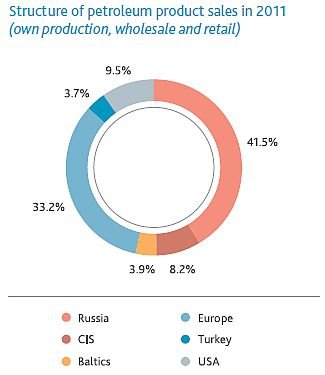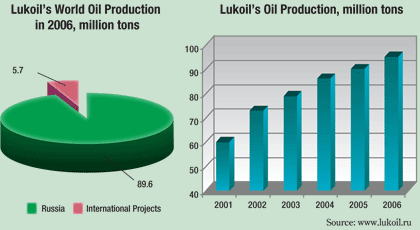Introduction
At a time when globalization and consumerism patterns have turned out to be the determining forces in the market, mergers and acquisitions among organizations are very critical in maintaining market capitalization, sustainability and subsequent development.
Consultants on mergers agree almost unanimously that the merging of companies is an important process that provides organizations with massive benefits.
From the study on mergers and acquisitions, Gurkov’s recommendations appear to cohere with those of other authors who indicate that the new entity easily reduces the non-constructive competition.
This paper presents a critical review of consulting opportunities in mergers and acquisitions with a focus on a Russian energy producer and oil company called Lukoil Oil Company.
A brief overview of Lukoil Oil Company
Lukoil Oil Company is one of the major Russian energy producing companies that generates, explores and markets oil and gas within Russia, the United States and Europe. The company is privately owned and has a significant refining capacity.
Its shares are listed in the New York’s OTC market (LUKOY), London (LKOD), Micex (LKOH) and RTS (LKOH) in Russia. It is headquartered in Moscow with operations in over 40 countries across the world.
Filippov indicates that the company was founded in 1991 as a result of a merger among Kogalymneftegaz, Urayneftegaz and Langepasneftegaz.
Since its inception, Lukoil has been selling petrol in over forty countries globally and in 59 regions within Russia. In 2009, the company had improved its reserves to about 9.3 trillion cubic feet of gas and 14.5 billion barrels of oil.

Lukoil Company has focused its major operations in Russia with several international expansions in zerbaijan, Uzbekistan, Venezuela, Colombia and Saudi Arabia. Its production of oil as well as its sales has been growing since the year 2000.
However, it has been faced by stiffer competition from other oil producers such as Exxon-Mobil. A merger is therefore an opportunity that will improve its efficiency, provide it with resources and information systems necessary for competitiveness in the global market arena.

Consulting opportunities-mergers and acquisitions
Gurkov indicates that consultancy is a very critical aspect that involves acquiring and sharing information and knowledge that is very fundamental for business growth and development.
Due to the fast-changing business environment in Russia, top-level managers in oil companies with special emphasis on Lukoil are seeking consultancy services with an intention of aiding their businesses devise better strategies of overcoming organizational uncertainties.
This clearly indicates the enormous awareness among organizations on the need for change and intervene professional on business matters.
It is worth noting that identifying consulting opportunities play pivotal role in the contemporary Lukoil business environment as it identifies opportunities for operational improvement services, strategy development, technology implementation, development of coaching skills and management of change.
This is because it brings frameworks and proprietary methodologies which aid in identifying problems within a business and which serve as foundations and component parts for recommending efficient and effective methods of carrying out business activities.
According to Sarah and Day, the need for mergers by Lukoil is based on the holistic need to formulate a common unit which guides its operations through assimilation of common objectives.
A matrix structure is therefore critical and should be assimilated to harmonize the regional and as well as the functional core commonalities amidst the emerging competitors.
Benefits of forming mergers and acquisitions
Since its formation, Gurkov credits the progress of the merger of Kogalymneftegaz, Urayneftegaz and Langepasneftegaz to the strategic management assimilated by the group company after 1991.
As the role of the committee of its managing directors shifted from planning to orient the future of the company with the different outsets, Gurkov argues that there was need to harmonize Lukoil’s operations to reflect the key objectives of the organization.
Merging with other companies will be critical in achieving the harmonization among other factors mentioned below.
Diversification and value consideration
The effect of merging with other strong companies will give its management a stronger grip and confidence towards approaching the fuel exploration outlook and marketing. There is need for Lukoil to articulate its goals from a common standpoint.
Besides, Gurkov indicates that coming together in a merger further creates a room for an expanded visionary orientation for the company. A merger can be considered as a critical platform for addressing petroleum exploration and its marketing on a global scale.
Therefore, the efficacy of its operations through mergers will be enhanced and this will also provide it with an opportunity to venture into other products such as natural gas, plastics and real estate operations.
Resources consolidation
One key evident aspect in the operations of Lukoil company is the emphasis on resource consolidation. According to Sarah and Day, the ability of any organization to evaluate and create an avenue for resource consolidation is vital for success to be achieved.
Though it is clear that Lukoil’s operations can easily flourish due to the highly reduced level of competition, it is possible to view the extra hidden potential that could be harnessed by merging.
Through mergers, it will be easier to team up and fully utilize the newly opened markets while increasing its supplies to meet the different insatiable demands many countries have for oil and gas products.
Furthermore, the essence of the resources consolidation is the inherent ability to participate competitively in all countries.
According to Sarah and Day, resource consolidation will anchor its easy entry into new markets either through exploration or in marketing its products in Europe and the United States.
Stages of consulting
Consulting is a process that requires setting up stages which will ensure client satisfaction and success in business endeavors.
In pursuing the massive opportunities which are presented by mergers and acquisition, consulting on key facets is important in guaranteeing success. Some of the key consulting phases that should be explored include:
Entry and contracting
Entry and contracting is an important phase in a project since it largely deals with a client. Filippov indicates that this phase is critical in the sense that it enables an independent business owner or company to deal diametrically and precisely with a potential client.
Some of the key tasks that entry and contracting encompass include figuring and setting initial starters and specifying expectations. The latter is important for understanding various expectations that a client has.
This is imperative since it sets a benchmark for determining the success of the other stages and whether or not one is the right consultant.
Besides, entry and contracting is a stage where a consultant explores the problem a business is facing, and which in most cases is diagnosed in the first meeting.
One of the advantages of the initial phase is the fact that it builds a working relationship. According to Filippov, the latter is very critical in creating an understanding of a business expectations and needs. It also aids a consultant in clarifying what a business ought to expect.
Filippov posits that while this is a crucial step, it is affected by lack of good perspectives and mutual willingness by businesses to invest and work together.
As noted earlier in the case of Lukoil company’s merger plans, it may be impossible to achieve the diverse benefits in the absence of mutual trust.
Data collection and diagnosis
Sarah and Day indicate that while exploring the problems facing a business is carried out in the first stage, a consultant out to come up with situations relating to a particular sense of problem. Gustov concurs with Sarah and Day by noting that creating a sense of problem is critical in adding value.
Consultants are therefore charged with the role of determining how to define a problem. This involves collection of data and diagnosing relevant problems.
The methods to be used in collecting data as well as the nature and type of data to be collected are very important variables that must be observed keenly.
One of the major opportunities of data collection and diagnosis is the ability to gather enough information on various business experiences.
This can be through methodologies such as impact/effort, brainstorming, SWOT analysis, force field analysis, meta-planning and focus group interviews. One such experience as discussed earlier is on mergers and acquisitions.
The information obtained is necessary in making critical analysis and relevant contributions. However, this process is normally affected by the inability of a company to avail, share and discuss information freely.
Feedback and decision
The data assembled on the opportunities presented by mergers and acquisitions present the diverse views stakeholders have on the issue.
A project owner in an organization is presented with the analysis of the information from feedback which seeks to create a deeper understanding of the problem.
Filippov indicates that feedback in consultations or any study is critical in identifying the context of an issue, its causes and consequences.
In terms of forming mergers and acquisitions, feedback is important in determining performance issues and or challenges that the move may have on a business.
Mergers and acquisitions have been known to strengthen businesses especially in cases where operation risks are extremely high for a single business entity to withstand.
Feedback and diagnosis is normally faced with the challenge of impacting on a business process. Filippov indicates that different managers or teams react to feedback in diverse ways. Besides, instances of rejection or resistance to projects are commonplace.
Training on how to handle both negative and positive feedback is critical in ensuring mutual understanding and that various challenges are effectively tackled.
Implementation
Deciding the way forward after a diagnosis is important in developing problem solving processes and devising possible action strategies. Some of the most common methods include being creative and innovative when dealing with issues and re-contracting responsibilities, roles and actions.
As the name suggests, this stage is mainly for organizations to carry out. However, consultants may be involved in ensuring the success of efforts. The challenges facing implementation is lack of required resources, commitments and desire for change.
Recycle, extension or termination
Finally, after evaluating the issues concerned, decisions are made to terminate the project or extend it. According to Filippov, the latter may follow an implementation process whereby the real picture of an issue is seen.
The success of an implementation may call for recycling and creation of new projects while moderate to high failure may call for termination. This process is important in determining viable and legitimate consultation practices as well as providing learning experiences.
Conclusions
To sum up, managerial skills are important leadership requirements that are critical in combining capacity, expertise and knowledge in specific areas of operations.
As noted in the discussions, consulting is one of the key areas where a business can be able to obtain relevant information and assistance on business projects.
The paper explored Lukoil company and noted that it should merge with others in order to improve its overall performance, expand its products and compete favorably in the already competitive global market arena.
Bibliography
Gurkov, I, “Strategy techniques for the times of high uncertainty”, Journal for East European Management Studies, vol. 15, no. 2, 2010, pp. 177-186.
Filippov, S, “Russian companies: the rise of new multinationals”, International Journal of Emerging Markets, vol. 5, no. 3, 2010, pp. 307-332.
Sarah, EAD & M, Day, “Leadership, administrative heritage and absorptive capacity”, Leadership & Organization Development Journal, vol. 28, no. 8, 2007, pp. 727- 748.